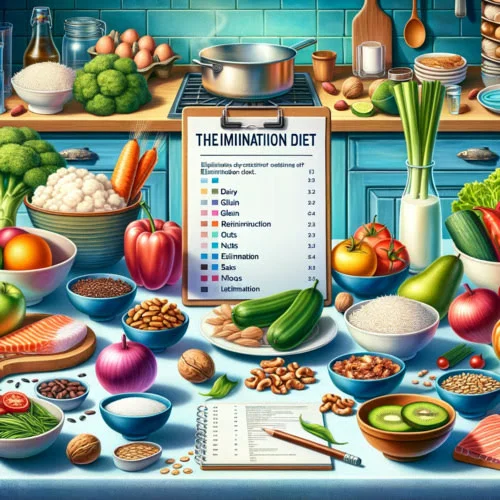In a world of diverse dietary approaches, the flexitarian diet deserves special attention. This approach to nutrition is not just a technique, but an entire lifestyle that combines the best of the worlds of vegetarianism and moderate meat consumption. I’m here to share my experience and knowledge about flexitarianism, which can be not only healthy, but also inspiring.
| Pros of the Flexitarian Diet | Cons of the Flexitarian Diet |
|---|---|
| Increases consumption of plant foods, reduces the risk of disease | Requires more careful diet planning |
| Eating meat in moderation reduces the risk of obesity | Does not provide some important nutrients |
| Allows you to create a flexible meal plan | It is necessary to carefully monitor the nutritional balance |
| Helps preserve the environment | The risk of misunderstanding the concept of flexitarianism |
| Provides a wide variety of food | May cause misperceptions and nutritional imbalances |
Definition of a Flexitarian Diet
Flexitarianism is not just a diet, but a nutritional philosophy based on flexibility and a smart approach to food choices. The main principle of the flexitarian diet is to increase your intake of plant foods while still allowing for small amounts of animal protein. This gives you freedom of choice while maintaining the principles of healthy eating.
Brief history and origin of the concept
The idea of a flexitarian diet was first introduced in the early 2000s, when vegetarianism and veganism began to skyrocket in popularity. Celebrity nutritionist Joe Baur, in his book Flexitarianism: Healthy, Delicious Eating Without Restrictions, emphasized the importance of a balance between plant-based and animal-based foods in the diet to achieve optimal health. Since then, the flexitarian diet has become not just a diet, but also a philosophy that attracts those who strive for a healthy lifestyle.
The flexitarian diet is based on flexibility and moderation in the consumption of different types of food. The main principles of flexitarianism are to increase the consumption of plant foods such as vegetables, fruits, grains, nuts and legumes, and to reduce the consumption of meat, especially red meat. This approach does not involve a complete abstinence from meat, but encourages conscious choice and preference for plant-based foods.
Explanation of the basic principles of the diet

The Flexitarian Diet emphasizes wholesome and natural nutrition, encouraging the consumption of nutrient-rich foods. This approach helps increase your intake of fiber, vitamins, minerals, and antioxidants for health benefits. The flexibility of this diet allows its followers to stay on a healthy eating path without feeling strict restrictions or deprivations.
Flexibility and Key Benefits
One of the key benefits of flexitarianism is its flexible approach. You can enjoy the benefits of a plant-based diet while minimizing your meat intake without having to give it up completely. This not only improves overall health, but also makes the transition to this diet smoother and more convenient for most people. The flexibility of the flexitarian diet also contributes to its long-term sustainability, making it more realistic to maintain over time.
Differences from other dietary approaches (vegetarianism, veganism, etc.)
Flexitarianism differs from vegetarianism and veganism in that it does not require a complete abstinence from meat or all animal products. Vegetarians and vegans exclude meat and all animal products respectively, while flexitarians prefer plant-based foods but can eat meat in moderation. This approach makes flexitarianism more accessible and acceptable to a wide range of people who want to improve their diet while maintaining flexibility in their food choices.
Nutrients in a Flexitarian Diet
Nutrients play a key role in the flexitarian diet, with the emphasis being on a variety of plant-based foods, fish and, in moderation, meat.
Emphasis on plant foods: vegetables, fruits, nuts, grains and legumes
A flexitarian diet emphasizes plant-based foods such as vegetables, fruits, nuts, grains and legumes. These foods are the foundation of the diet and are rich sources of vitamins, minerals, fiber and antioxidants. Vegetables and fruits, with their variety of colors and textures, enrich our diet and help support healthy skin, immune system and cardiovascular health.
The role of fish and meat in the diet of flexitarians
In a flexitarian diet, fish and meat serve as sources of animal protein and important nutrients. Fish, rich in Omega-3 fatty acids, is a key element in the diet of flexitarians, as it provides nutrition with beneficial fatty acids that influence brain and heart health. Meat, in moderation, can also provide valuable nutrients such as iron, zinc and protein, meeting the body’s needs for these elements.
The importance of nutritional balance and variety
One of the main principles of the flexitarian diet is to create balance and variety in the diet. A combination of different food groups—vegetables, fruits, grains, legumes, fish and meat (in moderation)—provides the body with essential nutrients. This balance helps maintain energy, health, and optimal organ function. Diet variety also helps avoid monotony and enriches the diet with useful elements.
Health and the Flexitarian Diet

The Flexitarian Diet is a unique approach to nutrition that can have a significant impact on a person’s overall health. Below are the main aspects related to this diet and its health effects. A flexitarian diet offers many health benefits, providing the body with all the nutrients it needs to maintain optimal functioning and prevent various diseases.
Positive health effects
A flexitarian diet rich in plant foods and fish is associated with a reduced risk of cardiovascular disease. Omega-3 fatty acids from fish and antioxidants from vegetables and fruits help strengthen the heart and blood vessels, reducing cholesterol and inflammation.
Reducing the risk of diabetes
A flexitarian diet, rich in fiber and low on the glycemic index, helps manage blood sugar levels. It may reduce the risk of developing type 2 diabetes and help manage existing diabetes.
Fight obesity
By eating foods high in fiber, low in processed foods and eating meat in moderation, a flexitarian diet can help control weight and prevent obesity.
Impact on energy and overall well-being
A flexitarian diet rich in vitamins, minerals and antioxidants helps increase energy. A healthy diet based on a variety of foods provides the body with the nutrients it needs to maintain high energy levels.
Improved overall well-being
A flexitarian diet enriched with nutrients helps improve overall well-being. Regular consumption of foods rich in antioxidants helps the body fight stress, strengthen the immune system and improve brain function.
Menu for the week

How to start following a flexitarian diet
Starting to follow a flexitarian diet is a great step for your health and well-being. It is important to understand that flexitarianism does not require radical changes. My recommendation is to start by gradually introducing more plant-based foods into your diet while gradually reducing the amount of meat you eat. This will allow your body to gently adapt to your new eating habits and will also make the transition easier for you.
Gradual introduction of new habits
The process of changing your diet can be gradual and effortless. Start by adding a greater variety of vegetables and fruits to your daily meals. Replace some of the animal protein with plant protein sources such as tofu, beans or peas. This will allow you to get valuable nutrients without having to give up meat completely. Remember that every small step brings you closer to your goal.
Tips for planning your diet
Planning is important when following a flexitarian diet. Start by creating a small menu for the week that includes a variety of plant-based recipes and moderate amounts of meat. Optimize your diet to include plant and animal proteins, as well as a variety of vegetables, fruits, grains and nuts. Gradually introduce new foods into your regular diet to provide a variety of nutrients.
By following these tips, you can start following a flexitarian diet smoothly and effectively, tailored to your individual preferences and needs.
Criticisms and limitations of the flexitarian diet

There is no doubt that the flexitarian diet has its benefits, but it is important to be aware of its possible limitations. One of the main things to watch out for is the risk of deficiencies in certain nutrients, especially when reducing your meat intake. Some micronutrients, such as iron and vitamin B12, which are typically found in meat, may be more difficult to obtain from plant sources. Therefore, it is important to plan your diet carefully to avoid deficiencies in these important elements.
Possible disadvantages and problems
When I think about the shortcomings, the question of the quality of the products consumed comes up. One key is to pay attention to the quality and origin of the foods in your diet. It is important to provide yourself with quality meat, as well as fresh and high-quality plant products. Keep in mind that the quality and freshness of food play a significant role in enriching your diet with valuable nutrients.
Additional points requiring attention
Another important point that is often overlooked is understanding the concept of a flexitarian diet. It is not always clear that flexitarianism is not simply about reducing meat consumption. It also involves increasing the consumption of plant foods. It’s important to find a balance that provides you with the nutrients you need. Pay attention to your diet so you don’t exclude food groups that may make valuable contributions to your health.
To summarize these points, remember that any diet requires careful planning. Flexitarianism is no exception. It opens the door to a wide range of nutrients, but requires awareness and balance to maintain your health.
Prospects for the development of a flexitarian diet

Recently, the flexitarian diet has gained the attention of people around the world. Her unique approach, which combines the benefits of plant-based and animal-based nutrition, represents a promising direction in the field of healthy eating. Many people are becoming increasingly conscious of the impact of their diet on health and the environment, making flexitarianism an attractive choice that offers the opportunity to combine health with respect for the environment.
Trends in world cooking and healthy eating
There is significant diversity and constant development in global culinary and healthy eating. The flexitarian diet, with its emphasis on plant-based foods and moderate meat consumption, reflects changing consumer preferences. The food market is seeing an increase in the range of vegetarian and vegan products, opening up new opportunities for flexitarianism and promoting healthy and varied food choices for everyone seeking balance in their diet.
Possible future changes or development of the flexitarian approach
In the future, the flexitarian diet may become more accessible and popular as people become more aware of the importance of balance in their diet. Many restaurants and food manufacturers are actively developing new offerings that combine the principles of a flexitarian diet with high quality and variety. However, an increase in information and educational programs to help people understand the benefits and principles of the flexitarian diet is expected, which could lead to its widespread adoption in the future.
Summarizing
The Flexitarian Diet is a highly appealing approach to nutrition that has a number of benefits. Its main benefit is that it allows people to benefit from a variety of plant foods while still being able to eat animal protein in moderation. This approach improves overall health, reduces the risk of cardiovascular disease and helps control weight. However, disadvantages include possible problems obtaining certain nutrients such as iron and vitamin B12, especially when reducing meat consumption.
In conclusion, the flexitarian diet is a powerful tool for those seeking balance in their diet. For those considering this approach, it is important to look for balance in the diet, including a wide range of plant foods, grains, nuts, and moderate consumption of meat. It is also recommended to consult with a dietitian or nutritionist to develop a personalized plan based on the individual’s needs and goals. In the future, the flexitarian diet has the potential to evolve further and could become a popular choice for those seeking a balance between plant and animal foods in their diet.
Flexitarian Diet – Frequently Asked Questions
– The Flexitarian Diet is a nutritional regimen based on moderate consumption of meat and increased intake of plant-based products.
– Plant-based products, vegetables, fruits, nuts, legumes, as well as a moderate amount of meat, fish, and other animal proteins.
– It helps reduce the risk of cardiovascular diseases, obesity, and provides flexibility in food choices.
– Vegetables are a key element, providing the body with essential vitamins, minerals, and fiber.
– Deficiency in certain nutrients, such as vitamin B12 and iron, especially when reducing meat consumption.
– Varied salads, vegetable dishes, buckwheat, beans, fish, poultry, and other meat alternatives.
– Plan the diet, focusing on a variety of foods, and ensure the intake of necessary nutrients.














